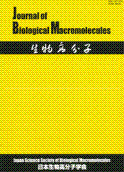Gymnemic acid II (GA II) is a saponin of triterpene glycoside isolated from the plant Gymnema sylvestre. It suppresses taste sensitivity to sweetness and inhibits intestinal glucose absorption. We found GA II inhibited glycerol-3-phosphate dehydrogenase (G3PDH) activity noncompetitively with a substrate, dihydroxyacetone phosphate, and induced band smearing of G3PDH in SDS-PAGE in a time-dependent manner; band smearing was observed but decreased when G3PDH was incubated with GA II for 1.5-2 h compared with smearing after incubation with GA II for 4 h. NADH was more effective than NAD for decreasing the smearing of the G3PDH band, suggesting that GA II distinguishes between NADH- and NAD-bound forms of G3PDH. The smearing of the G3PDH band was diminished by prior incubation of GA II with gamma-cyclodextrin, but the suppressing effect of gamma-cyclodextrin was decreased when G3PDH was incubated with GA II for 0.5 h before adding gamma-cyclodextrin. These results suggest that the induction of the band smearing of G3PDH by GA II proceeded in two steps. GA II bound G3PDH and inhibited G3PDH activity but did not induce band smearing in SDS-PAGE during the first stage. Then, GA II induced a change in G3PDH that caused band smearing during the second stage, and the suppressing effect of gamma-cyclodextrin on band smearing was decreased at this stage. Analysis using in-gel digestion coupled with mass spectrometry suggested that proteolysis at the amino acid A238-F251 region of G3PDH was affected by treatment with GA II.
抄録全体を表示
